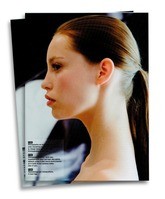In the news
Rhinoplasty : ”Officiel de la chirurgie esthétique” magazine
Latest trends in nose treatments
Today, no one wants to get just a ”nose job” anymore. Nose treatments are about embellishing the nose, correcting its anomalies, but fully respecting its natural uniqueness. Modern rhinoplasty has become a refined artistic procedure with a much faster recovery.
(Interview with Dr. Hervé Raspaldo, by Paule Cornille)
Whether the nose is hunchbacked, crooked, too big,too wide, too short, too hollow or the patient had a surgery that went wrong, we can make any nose look better. Sometimes,it only takes a few millimeters here or there, to reveal the beauty of a faceandthe perfection of features. The embellishment work is performed on all angles, front, three quarters and profile. A good surgeon does not only focus on the nose, but considers the face as a whole, and aims the most natural and harmonious results possible.
The practitioner uses the 3D morphing during the first consultations, in order to have a practical exchange with the patient and make useful suggestions on the different nose treatments.This technology makes it possible to clearly visualize the rhinoplasty project in three dimensions. However, before any procedure, the surgeon must check that the nasal septum is not deviated, he does this using a small endoscope and a camera. He may also use a laser to improve the air passage inside the nasal cavity,because there is nothing more unpleasant than having a nice nose but not being able to breathe.
A minimally-invasive technique
Using micro-instruments and a video camera (endoscope), the surgeon will have perfect control over his actions, making the procedure much less traumatic. All the work is done inside the nose, so there is no visible scar. There are no stitches to be removed either, they are all resorbable. This procedure has become almost painless. Some discomfort may be caused by the small cottons or absorbable pads that force the patient to breathe through the mouth the first night. There will also be a small splint to support the reshaped nose, but it will be removed on the sixth day. Since this resin splint is much more comfortable and more discreet than the old plaster molds, the patient has a nearly normal life the next day. However,exercising should be avoided for a monthafter the procedure! Oedemasand bruising can occur near the eyes forten to fifteen days, but the result can be seen after eight days.
Cryotherapy can help overcoming these small inconveniences – very cold air is sprayed on the tissues, a procedure that is also used for treating athletes’ injuries. Lymphatic drainage can also be helpful. In the last twenty years, the unpleasant nasal packings have been replaced by resorbable pads and if the nasal septum is in perfect condition, there is no need for any internal dressing. All these medical progresses have made it possible to get a better result, in a shorter time. Let’s just remember that fifteen years ago, the patient had to wait for a month before resuming normal activity, whereas today you can wear makeup the following day.
The embellishment treatment is performed on all angles, front, three quarters and profile. The morphing, a 3D imaging system allows the patient to see the reshaped nose on a screen before the procedure.
AULINE V. : ”I really saw the difference when I looked at my pictures”
“My face is rather long,with prominent cheekbones, and I always thought that my nose, although straight, was too long and too wide to fit in. So I decided to shorten ita little, and to reduce the size of the nostrils. The procedurewas not painful.After the procédure, I only felt a slight discomfort when breathing, in the first weeks. At first, my nose was swollen and it seemed wider than before, soI was a little disappointed. But then it started to become thinner and after a few months, it had its new, permanent shape.
It didn’t look like a nose job at all, and my new nose fitted perfectly in my face, as if ithad always been like this. But I really realized the change when I looked at my pictures: I was just much more photogenic. A little later, I had another procedure to make my nostrils a little rounder, because I thought their shape was a little too sharp. It was a simple and quick procedure – using a cartilage graft behind the ear – and this improved the results even more. “
Prerequisites
Puberty is the minimum age prerequisite for rhinoplasty. When performed correctly, the procedure can provide enormous satisfaction, both aesthetic and psychological. For an adult patient, it can make the face look younger, similar to a facelift but in a much easier way. The patient should consult one or several surgeons before considering the procedure. Once the choice is made,two preliminary consultations must be scheduled with the practitioner. The latter will use digital photos and morphing to suggest treatments,discuss the nose reshaping possibilities and understand the patient’s expectations. After the treatment has been decided, the patient will receive a complete consent document explaining the benefits and risks, as well as the costs involved. Even thoughthe risk is kept to a minimum, a period of reflection is mandatory for patients before undergoing surgery. The procedureusually lasts less than one hour and hospitalization does not exceed twenty-four hours.
Patients may stay in the clinic for one night, but a lot of them are able to safely leave the hospital in the evening, if the surgery was performed early in the morning.
Before surgery, the skin is deeply cleansed and the surgeon will have been informedif the patient has a tendency to acne or pimples. ”There are subtle ways to correct a bump on the nose, or a nose that is too long; rhinoplasty can also solve more challenging problems, like injuries caused by an accident, major congenital malformation or bad results from a previous nose surgery. In these extreme caseswe are dealing with reconstructive rhinoplasty, but despite the technical difficulties, we must always have an aesthetic approachas well”, says Dr. Raspaldo. As for the touch-ups, they are only required in 5% of the cases and must always be scheduled prior to the surgery. They are simple corrections, most often performedunder local anesthesia.


